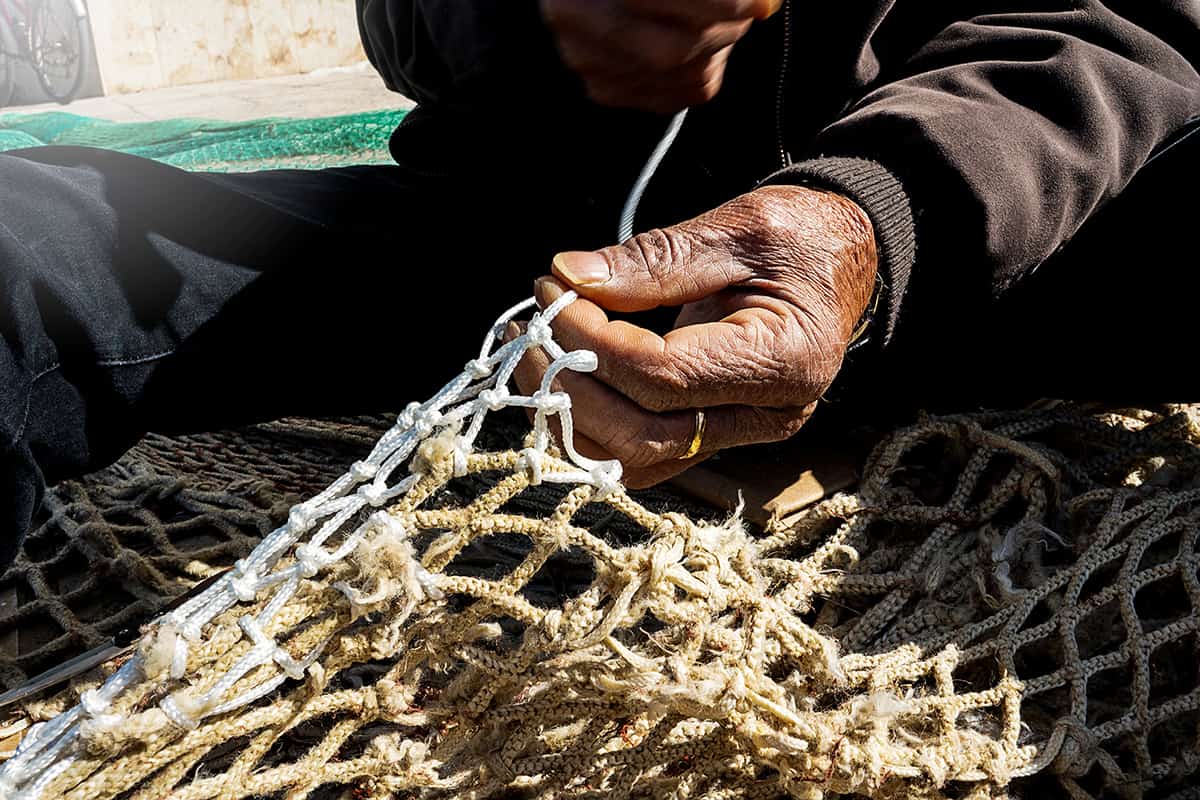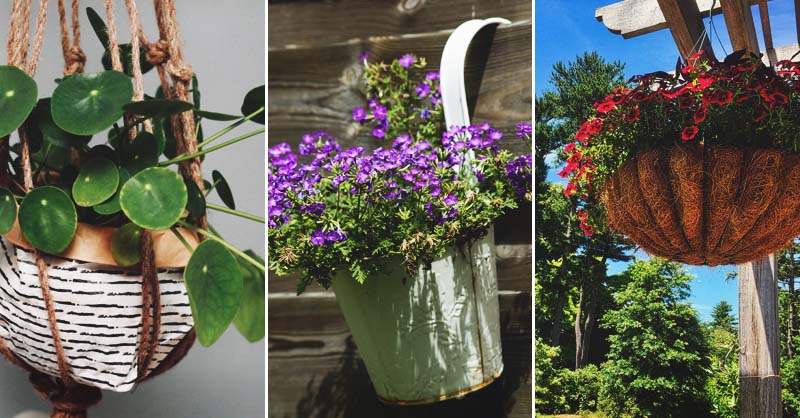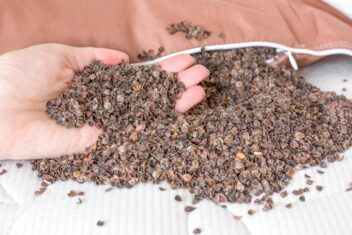If there’s one thing I’ve learned on my journey towards self-sufficiency, it’s that it’s good to know a variety of fishing techniques. We’ve already covered the awesomeness that is making fish traps, but what about nets?
These are easy to put together, and even easier to use. Read on to learn about three different basic net-making techniques: woven nets, tied nets, and knit/crochet nets.
How Do You Fish with Nets?
Okay, this is where I crack my knuckles and get typing in earnest. There are several different ways to fish with nets, and each one has its pros and cons. Some types are active while others are passive. This means that you’ll have to engage directly with the former to catch your fish, and with the latter, you can just leave a net somewhere and come back to it later.
Let’s take a look at some of the most common net-fishing techniques to illustrate this point.
Drag Net
No, not the classic police drama series. A drag net is rather self-explanatory in that you drag it along the bottom of wherever you’re fishing. You need to attach weights to the edge of the net’s bottom for it to be effective. Otherwise, it’ll just glide behind you like a cape. This catches fish as you pull (trawl) it behind you.
Use this method if you’re using a small boat to catch your fish.
Coracle Net
Similar idea to the one above, only it’s dragged between two small boats. Once you’ve caught some fish, you bring the boats together and draw the net closed. This is a great technique if you and some friends have found a big shoal and you’re keen to work together to harvest it.
It’s also ideal for collecting a lot of fish at once, for when you’re making things like canned fish soups, or drying it for harðfiskur (Icelandic-style dried fish: great for storing long term!).
Seine Net
This is a similar technique to a drag net, only it’s done with two people, rather than behind a boat. The net’s bottom is weighted, and then it’s stretched out in a fish-dense area. The fisherpeople then trawl with it and eventually move together to ensnare the catch. A strong woven net is perfect for this method.
Check out this video as an example of how it works:
Cast Nets
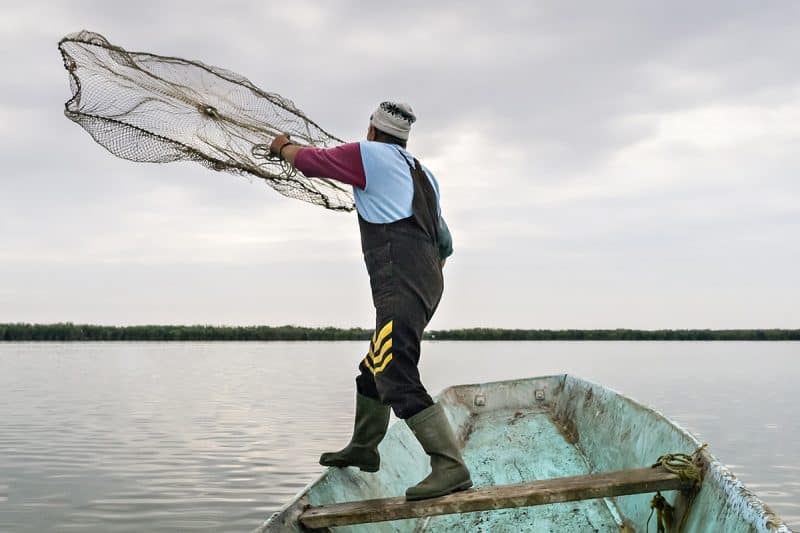
These are thrown out over a shoal of fish. Sometimes they catch several of them, but the technique can be hit or miss, and it only really works well for really dense shoals. Woven or tied nets are great for this method.
Hand Nets
As their name should imply, these are nets you use by hand. You attach a bag-like net to a handle and then swoosh it through the water, trapping any fish swimming nearby. One of the easiest ways to make these is by repurposing old, broken badminton or tennis rackets. I’d use a crocheted or fine tied net for this.
3 Different Methods of Making Nets
There are many waves to make nets, and each is suited to various techniques.
1. Woven Nets
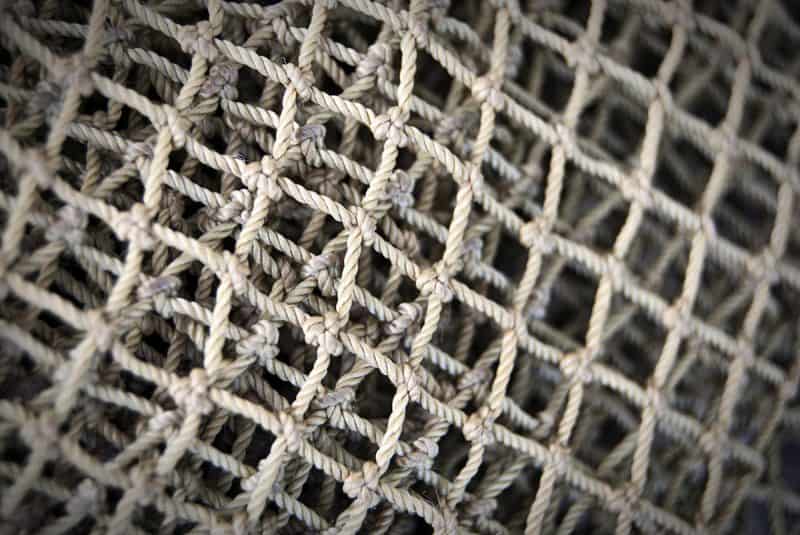
This is one of the most common, ancient types of fishing net. You can make these with any type of cord or twine, provided that you have a netting shuttle (or net needle) that’s the right size.
What You’ll Need:
- Heavy cord or other frame for the top and bottom of your net
- Several yards of the net weaving cord or twine of your choice
- A netting shuttle/needle
- Weights (optional)
Secure the heavy cord or frame somewhere so you can work without it jumping all over the place.
Next, take the material you’ll be weaving your net from. Load this onto your netting shuttle by wrapping it underneath into the open wedge, then over the barb at the midpoint. Do this alternating front and back until you have enough string to work with.
Keep in mind that the shuttle will have to be able to push through the holes you’re weaving. If you want your net holes to be 4″ in diameter, and you’ve loaded the shuttle so it looks like a football, it’s not going to work.
Start Weaving
Attach your net string to the frame or cord with a clove hitch. Then make another a few inches along, leaving a bit of string loose between them. As you keep working, you should have what looks like a bunch of “U” shapes between each hitch knot.
Once you’ve worked your way across your frame, it’s time to start weaving the net. You’ll be working your way back and forth, so for this row, you’re working back towards where you started. Pass the cord into the bottom of the U shape to the left, leaving enough slack to create the size net hole that you want. Then pinch the bottom of the U tightly, along with the piece of string you just wove through.
Throw a bit of loop across your hand, leaving it slack. Then push your shuttle around the back of the pinched bit, and up through that empty loop. Pull it through, drawing it closed tightly.
2. Tied Nets
These nets are incredibly easy to make. They’re not as durable or long-lasting as the others, but they’re good for putting together quickly.
What You’ll Need:
- Several meters of cord or twine
- A sharp knife
The previous example involved weaving a net out of one continuous length of cord. In contrast, this technique involves cutting several pieces of cord and tying them to one another. Basically, this is fishnet macrame. If you have an older aunt who makes hanging planters or wall hangings with knotted yarn, she can probably help you out with this technique.
You can tie the knots as far apart or as close together as you want to create a fine mesh or a wider mesh.
Secure a length of cord between two solid hanging objects, like a couple of door handles. Whatever will remain stationary for you to work on. Alternatively, you can use this technique for making a hand net with one of those aforementioned tennis rackets, a hula hoop, or some other solid frame.
Use the knife to cut several lengths of cord the same length, keeping in mind how much they’ll shorten as you work. This means that if you cut a 10-foot length of cord, you’ll end up with a 5-foot long net.
Get Tying!
Tie these to your main, horizontal cord or frame, spaced evenly at regular intervals. I use a basic cow hitch (aka “lark’s head” hitch), but you can use whatever type of hitch knot you like best. Just make sure you’re tying the middle of the cord to the frame, so the dangling ends are the same length.
Once all those are tied in place, find the center space, and grab a piece of cord from either side. For example, let’s say that you have 6 cords dangling down. The center space will be between cords 3 and 4.
Take those cords (again, one from the left, and one from the right), and tie them together with a basic overhand knot. This will create a downward-facing triangle. Do the same thing across the entire row, so you have a bunch of downward-facing triangles, all the same height.
Once those are done, move down to the next row. This time, you’ll tie the alternating pieces together to create diamond-shaped spaces. Check out the tutorial below for visual tips:
3. Crocheted Nets
Crocheting a fishing net is ridiculously easy. In fact, it’s both easy and a great way to while away a dark winter evening.
What You’ll Need:
- Waxed cotton thread or nylon fishing line
- Nylon cord
- Metal crochet hook between 1 and 2.5mm in size: Make sure you use a metal hook. Wooden and plastic crochet hooks are lovely, but they break easily when they’re this thin.
Start making your cord by chaining 10 chain stitches (ch st). Then create a circle with the chain you just made, and slip stitch it (sl st) it into place.
Next, ch 1 in the circle space you just made, ch another 10 stitches, and form that chain into a loop with a sl st. Repeat this process 10 times. You’ll end up with something that looks roughly like a daisy.
Make a sl st in the first loop you made, ch 6, then do a double crochet (dc) stitch in the next loop space. Check out the video below for a step-by-step visual guide to this technique.
Repeat this process pretty much indefinitely until your net bag is the size you want it to be. Then finish the edge by doing 3 or 4 sc stitches in each loop as you work your way around it. Finish with a sl st.
The video below has a tightener cord around the edge, as it’s used as an all-purpose net bag. If you’re using this as a hand net, just attach the open end to your frame. I use heavy twine and clove hitches for this, but you can also use a darning needle and blanket stitch it onto the frame instead.
Natural Net Materials VS Synthetic
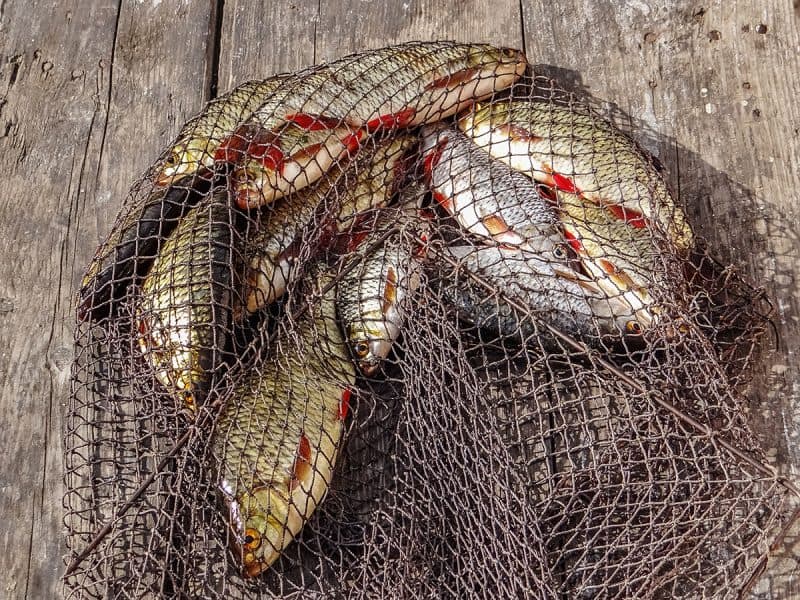
Here’s where we start weighing the pros and cons of various netting materials. The eco-savvy, back-to-the-land part of me loves to work with natural materials. Furthermore, since cotton, linen, and silk fibers are biodegradable, they’ll break down if they fall into the water.
In contrast, nylon and polyurethane fibers will keep floating around pretty much forever, harming the local ecosystem exponentially.
That said, the aforementioned synthetic fibers are a lot stronger than natural ones. A big, strong fish can easily thrash its way free from a cotton or silk net. That same fish, however, will be held fast by the strength of a nylon net, even if it’s finely woven.
Ultimately, it’s up to you to decide which fibers are best suited to your needs. Weigh the pros and cons, and determine cost and labor, as well as how often you’ll need to do replacement/repair work.
